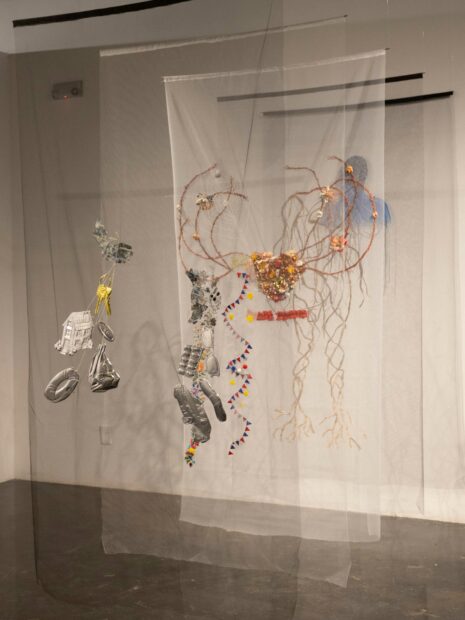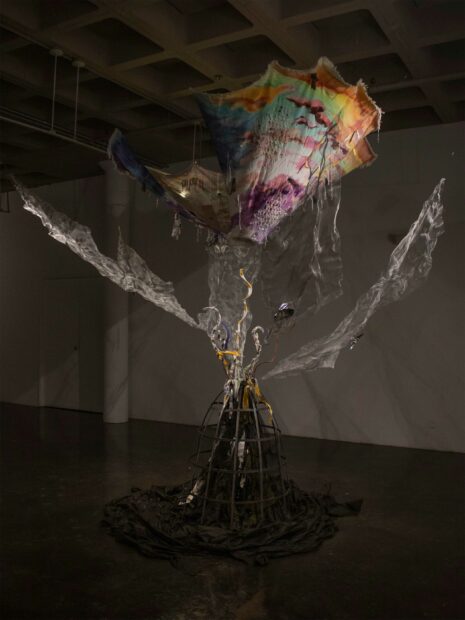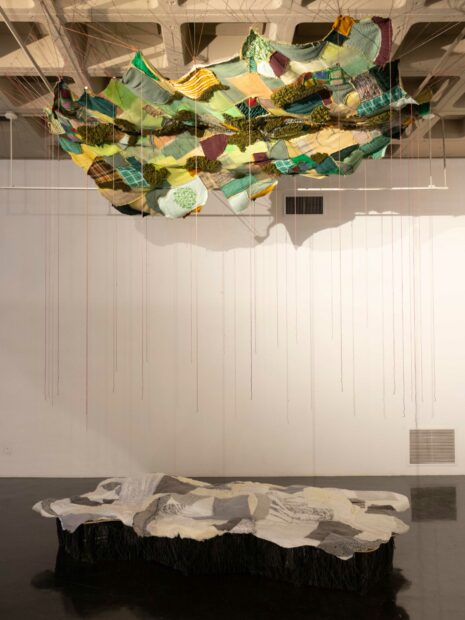It is April 2024, and I am in the west room of the University of Texas at San Antonio’s (UTSA) Russell Hill Rogers Galleries to chat with Angeles Salinas about her Master of Fine Arts thesis exhibit. I met Salinas while I was a graduate student in the Master of Art History program at the school. I remember first seeing her studio last spring; her space was abundant with pins, silhouettes of dresses, and vibrant fragments of cloth.
Salinas, a Mexican-born artist, came to the United States from Mexico in 2015, when she began her post-secondary education at San Antonio College. Salinas transferred to UTSA in 2017, where she obtained a Bachelor’s in Fine Arts in 2020. Shortly afterward, she enrolled in the Master of Fine Arts program.
Almost a decade has passed since Salinas first came to the United States in her pursuit of higher education. During this time, she has not only learned English, but also juggled the reality of life as a single mother. Salinas deconstructs and simultaneously reveals her identity and sense of place through her practice. This negotiation is embedded into fabrics, some of which lay on the floor in her show, and others that hang from the gallery roof. Salinas not only expresses her cultural and personal identity in her artwork, but also her personal circumstances. In this show, viewers get a glimpse of the artist’s world through various fabric works that can be experienced as much as they can be seen.
Christopher Karr (CK): You use textiles in much of your work — can you tell us why?
Angeles Salinas (AS): When I started the Master of Fine Arts program here at UTSA, I simply went back to the crafts that I learned during my childhood. I was an extremely hyperactive child. My mother was always looking for stuff for me to do. And of course, she went for traditionally women-associated crafts. She kept me entertained by making me do needlepoint, crocheting, and stuff like that.
I was interested in creating visual stuff. I was not into knitting. I am concerned with materials related to Mexican crafts. I use these materials in large part because they were present in my childhood. Embroidery and knitting refer to my heritage as a Mexican-born woman.
Just last summer, in 2023, I went to Mexico to renew my visa. That whole summer, I made dresses. I thought, “I really need to be making some artwork.” But I couldn’t stop making dresses. While making dresses, I began to think about my childhood again. My abuela was my seamstress teacher. She taught me how to sew garments, beginning when I was fifteen years old. Ever since then, whenever I’ve been in difficult economic situations, I buy fabric and make garments. Making clothes is a soothing way of telling myself, “You can do this, and everything will be okay. You have a solution in the palm of your hand.”
For me, sewing is a matter of creating for need, but it is also soothing. Making garments in Mexico is a need, which is different from the United States, where people make clothes more as a hobby. Fabrics in Mexico are worth a tenth of the value compared to the fabrics here in the United States. Also, sewing is not unique to me. Sewing is passed through generations of women, and in my case, from the women in my family.
This show is all about the experiences that I have both lived through and the heritage I have acquired as a Mexican-born and raised woman who now lives in the United States. The show touches on everything that has happened to me since I moved to the United States three years ago. I’ve become this new and different person.
CK: Would you say you are in Nepantla? In a nutshell, this is the term that Chicano scholars use for the “in-between” space of the Mexican and United States experience. You are not Chicana, but you suggest that you are in this space. Am I correct?
AS: Absolutely. I am going back and forth between English and Spanish constantly, both in my head and while communicating with others. I’ve been uprooted. Think of the name of this show, Uprooting: Paths to Belonging. The show is a search. Yes, it’s autobiographical, but hopefully other people can think of how they are searching for themselves, too.

Angeles Salinas, “Anatomical Dissection,” 2023, one dollar bills, twenty peso bills, thread, aluminum foil, resin, raffia, fabric, yarn, wire mesh. Photo: Christopher Karr.
CK: Anatomical Dissection is the first artwork one encounters in the show. The artwork embeds different, layered symbols. Tell me more about the symbols. What is their significance?
AS: There are five layers here. The artwork is about women, and how women bear the weight of the home. This is how I feel. This artwork is layered not just in material, but also, content. That is why this artwork is the introductory piece. When someone walks in and looks at this artwork, I want them to understand both metaphorically and literally that they are looking at a layered person. I want them to remember that they are layered, too.
The first layer of this figure shows burdens and responsibilities. For example, the figure holds money, which is both a 20 peso and a $1 U.S. bill. Women spiders weave webs, and I weave fabric. The second layer shows us motherhood, and how I am standing in a difficult position. One leg represents Mexico, with its embroidery of floral patterns, and the other, the United States, with flags and stars. The middle of the anatomical dissection is a heart in the place of the pubic triangle. The fourth layer is strands of natural fibers. This refers to communication, and about how I am trying to find roots and grow. This person is confused, which you can see by the fifth and last layer: the head that has messy designs and thoughts.

Angeles Salinas, “Toad, from the Malagros Series,” 2022-2023, aluminum foil, resin, yardsticks, dimensions variable. Photo: Christopher Karr.
CK: Now, let’s talk about Malagros. There’s a mixture of symbolism that’s both pop-cultural to the United States and Mexico. There’s complexity here, with the ladders and different objects in frames.
AS: Here, I’m playing with the idea of the game Chutes and Ladders. In Mexico, we have a similar game, but it’s called serpientes y escaleras, or serpents and ladders. These games are nearly identical. I am captivated by the idea of luck. Life is essentially us throwing dice. Life is a game.
I made my ladders out of yardsticks, which we use to measure ourselves. Milagros are tiny icons from the Catholic religion that believers attach to thick, wooden crosses or sacred hearts. These Milagros are used in ex-votos, which depict miracles performed. People make offerings to saints for the miracles they perform through ex-votos.
However, I created what I dub Malagros, which answer prayers with questions. They’re annoying. You do not win in this game that I have created. We are always trying to figure out who we are. Think about it. We often compare ourselves to others. We are too tough on ourselves.
CK: Your malagros are attached to your life. Inside your ex-votos are malagros of a rat, spider, teeth, and black butterflies, to list a few. Some of your malagros are quite negative, aren’t they?
AS: Definitely. Imagine having all of these prayers for a beautiful life, but then life gives you a toad!

Angeles Salinas, “Sky-Escape,” 2023, acrylic paint on aida cloth, old dresses, steel bars, newspaper, fabric, thread, yarn, aluminum foil, wire mesh. Photo: Christopher Karr.
CK: In the show, the piece Sky-escape suspends from the gallery ceiling. Why does this one hang, instead of presenting itself as a dress that flows down?
AS: This artwork has changed from what I thought it would be. The dress used to go over the cage, but that was not working. Instead, I’ve deconstructed this dress, and now it feels complete. Beginning from the bottom, we see black fabric that goes up to the interior of a cage. Right above the cage are extensions of colorful fabric. Moving up, there is more colorful fabric, suspended from the ceiling.
I’m always referencing the female psyche. I do this through the body, the mind, and the idea of the dress. Clothes are something we choose to wear every morning. We can wear things that are similar or completely different. But ultimately, the idea of the dress is imposed on women. I can choose to make my own dress, though. I can choose differently.
CK: You are questioning the role of women.
AS: Absolutely. I am deconstructing femininity. Maybe all of these roles are a cage. If it were not for those roles, then would I be an artist? Would I be who I am?

Angeles Salinas, “The Space Between,” 2024, repurposed clothing, fabric, acrylic paint, yarn. Photo: Christopher Karr.
CK: The artwork The Space Between also hangs from the ceiling, but has these hanging threads that enclose the space. Can you talk about that?
AS: With these hanging threads, I am creating a dome. It creates intimacy between the space and the viewer. The whole point of this artwork is to provide a sense of pause in place. Your thoughts here are metaphorically and literally pondering the landscape above you that is separated by a river. These are my thoughts.
I am constantly thinking about placement as a migrant, and I give those thoughts to the viewers when they enter this space.

Angeles Salinas, “I Can Fly,” 2024, wedding dress, fabric, wooden dowel, bobbin lace, wire mesh, ribbon, and video projection. Photo: Christopher Karr.
CK: One of the artworks in the show is a wedding dress that has haunting black butterflies on it. Can you tell me what they mean? Are the butterflies an addition you made?
AS: This is my wedding dress. My mom made this dress. Of course, she did not do this alone. My abuela consulted with my mother as she sewed the dress, so it was something they made together. And yes, the butterflies are mine. This dress is influenced by multiple generations of women.
I am divorced. Perspective is important here. My wedding dress is a point of departure, but we think of a wedding dress as part of that symbol of unification between people. Again, I added the train of silhouetted black butterflies. I have accepted everything that has happened to me. The butterflies are consuming, but they also rise up.
CK: Butterflies recall migration. Monarch butterflies, in particular, are known to migrate these long distances. They come to Mexico, but you have come to the United States. This is a layered artwork, then, that also reveals migration.
AS: Yes, this is a mourning piece, but it’s also a piece that reflects on renewal and coming out of the ashes. I’m touching on migration. Remember, I deal with this duality of place all the time. This is why I put the phrase “I don’t remember when I stopped believing I can fly” in English. The “I can fly” is on the floor. Sometimes you lose yourself. In many ways, I am still finding myself because of the things that have happened to me.
CK: Sometimes we choose what happens to us, and sometimes we do not. Regardless, you’ve transformed, and you are someone new. Like a butterfly, you are in a new stage of life for yourself.
AS: This is a new beginning for me as an artist, as a mother, and as a person in the United States.
Uprooting: Paths to Belonging is on view at the Russell Hill Rogers Galleries at the University of Texas at San Antonio Southwest Campus through April 27, 2024.


